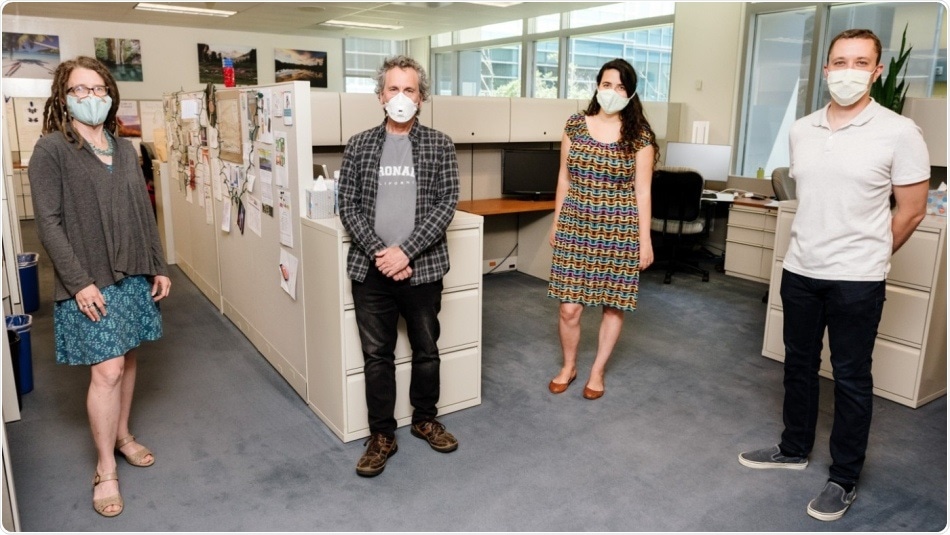A finely adjusted sequence of genetic events should occur to allow the budding brain of a human embryo to turn into the complex organ that regulates human consciousness. In other words, an unlimited number of genes are both activated and deactivated in an accurate symphony.

Director of the Gladstone Institute of Data Science and Biotechnology Katie Pollard (left), worked with John Rubenstein, Eirene Markenscoff-Papadimitriou, and Sean Whalen to map the genomic regions that control the development of the human brain. Image Credit: Gladstone Institutes.
Mutations that occur in these genes interrupt the molecular instruments of the symphony. If such mutations take place in genes that are significant for brain development, they can lead to neurological disorders, like epilepsy and autism.
For a long time, scientists have struggled to figure out how mutations in regulatory areas of the genome—the conductors, instead of the instruments—can also make this procedure go wrong.
At Gladstone Institutes and UC San Francisco (UCSF) Weill Institute for Neurosciences, scientists have now developed a detailed region-specific atlas of the regulatory areas of the genome associated with the brain development of human embryos.
This gives us a searchable, data-rich atlas of part of the developing human brain. This is a valuable tool for probing the underlying biology of neurodevelopmental disorders.”
Katie Pollard, PhD, Director of the Gladstone Institute of Data Science and Biotechnology
The senior authors of the latest study are Pollard and UCSF professor of psychiatry John Rubenstein. The study was published online in the Cell journal.
Only about 2% of the human genome encodes the real genes. Most of the remaining genomes consist of regulatory elements—the conductors that regulate where and when those genes are activated.
For instance, genes crucial for certain features of liver function do not have to be switched on in the brain cells; hence, various regulatory elements are required to regulate the expression of genes in those tissues.
When scientists examined the DNA of individuals affected by neurodevelopmental disorders, they usually expose dozens, if not hundreds, of natural changes in DNA sequences. But only a small number of those variants may be associated with the disorder itself, and identifying the ones that are curial is quite difficult.
Much of the genome is still this vast and mysterious place because we don’t know which parts of the genome play roles in which tissues.”
Eirene Markenscoff-Papadimitriou, PhD, Study Co-Author and Postdoctoral Researcher, UCSF Weill Institute for Neurosciences
In the latest study, the scientists analyzed cells from a part of the developing human brain known as the telencephalon. This area contains structures that are responsible for communication, language, sensory processing, and voluntary movement.
The researchers leveraged the fact that within the cells, the genome is firmly wound into a thick structure called chromatin. This three-dimensional (3D) structure exposes the crucial parts of the genome in any specified cell by revealing the stretches of regulatory DNA required for cellular function.
The researchers used a technology, known as ATAC-seq, to cut up the exposed DNA in the embryonic brain cells. When the researchers analyzed the areas where these cuts are made, they were able to deduce which portions of the genome are revealed and likely to contain significant regulatory regions by examining where these cuts are done.
The preliminary experiments of the researchers exposed over 103,000 areas of open chromatin in the developing brain cells. The scientists used a machine-learning method to narrow down that list. They wrote a computer program that employs previously known data about regulatory DNA to help trace patterns that are specific to brain cells.
We wanted to whittle this initial list down to a smaller set that was the most likely to be important to regulating brain development.”
Sean Whalen, PhD, Study Co-First Author and Research Scientist, Gladstone Institutes
In case a regulatory region was analogous to one known to be active only in lungs or limbs, for example, the machine-learning program will conclude that it was not a brain-specific enhancer. The team finally revealed a set of around 19,000 regulatory regions of the genome anticipated to play a role in the development of the brain.
To demonstrate the utility of the novel dataset, the scientists peered more closely at two parts of the genome that emerged in the new atlas; this genome had earlier been implicated in epilepsy and autism.
The DNA sequences demonstrated by the scientists actually served as enhancers in brain cells—they had the potential to switch on genes.
According to Markenscoff-Papadimitriou, “We can now use this approach to ask how all sorts of other mutations affect the non-coding genome. This atlas points us in the direction of specific brain regions that are affected by genetic mutations.”
For example, if the researchers are able to identify scores of genetic variants related to a neurodevelopmental disease, they can currently use the atlas to validate which types of variants are part of the 19,000 regions detected as important for brain development.
Such a process can assist the researchers to spot which variants are useful for follow-up studies, instead of devoting months testing genetic variants that end up to be irrelevant to diseases.
According to Whalen, “We think our data will help a lot of other research groups further their work.”
Besides studying diseases, the resource will be valuable for basic science to learn more about brain development, Whalen concluded.
Source:
Journal reference:
Markenscoff-Papadimitriou, E., et al. (2020) A Chromatin Accessibility Atlas of the Developing Human Telencephalon. Cell. doi.org/10.1016/j.cell.2020.06.002.